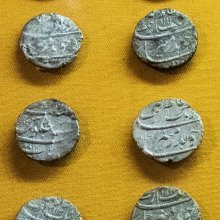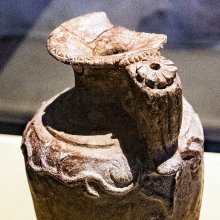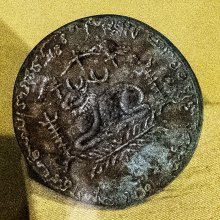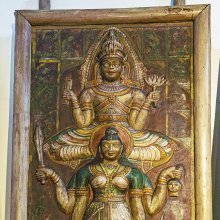Namin, Nāmin: 5 definitions
Introduction:
Namin means something in Hinduism, Sanskrit. If you want to know the exact meaning, history, etymology or English translation of this term then check out the descriptions on this page. Add your comment or reference to a book if you want to contribute to this summary article.
Images (photo gallery)
(+14 more images available)
In Hinduism
Vyakarana (Sanskrit grammar)
Source: Wikisource: A dictionary of Sanskrit grammarNāmin (नामिन्).—(vowels) which cause cerebralization; the ten vowels ऋ, ॠ, इ, ई, उ, ऊ, ए, ओ, ऐ, औ (ṛ, ṝ, i, ī, u, ū, e, o, ai, au); cf. ऋकारा-दयो दश नामिनः स्वराः (ṛkārā-dayo daśa nāminaḥ svarāḥ) R. Pr. I. 27, cf. also R.T. 94. See the word नति (nati). The word भाविन् (bhāvin) is used for नामिन् (nāmin) in the Vajasaneyi Pratisakhya; cf. अकण्ठ्यो भावी (akaṇṭhyo bhāvī) V. Pr. I. 46; cf. also नामिपरो रम् (nāmiparo ram) Kat. I.5.12.

Vyakarana (व्याकरण, vyākaraṇa) refers to Sanskrit grammar and represents one of the six additional sciences (vedanga) to be studied along with the Vedas. Vyakarana concerns itself with the rules of Sanskrit grammar and linguistic analysis in order to establish the correct context of words and sentences.
Languages of India and abroad
Sanskrit dictionary
Source: Cologne Digital Sanskrit Dictionaries: Cappeller Sanskrit-English DictionaryNāmin (नामिन्).—1. [adjective] = nāmavant.
--- OR ---
Nāmin (नामिन्).—2. [adjective] bending; changing into a cerebral ([grammar]).
Source: Cologne Digital Sanskrit Dictionaries: Monier-Williams Sanskrit-English Dictionary1) Nāmin (नामिन्):—[from nāma] 1. nāmin mfn. having a name, [Rāmatāpanīya-upaniṣad]
2) [v.s. ...] 2. nāmin mfn. bending, ([especially]) changing a dental to a cerebral (said of all vowels except a and ā), [Prātiśākhya]
[Sanskrit to German]
Sanskrit, also spelled संस्कृतम् (saṃskṛtam), is an ancient language of India commonly seen as the grandmother of the Indo-European language family (even English!). Closely allied with Prakrit and Pali, Sanskrit is more exhaustive in both grammar and terms and has the most extensive collection of literature in the world, greatly surpassing its sister-languages Greek and Latin.
See also (Relevant definitions)
Starts with: Nami-nantiatikanayanar, Naminatha, Naminathagita, Namini.
Query error!
Full-text: Avanamin, Anamin, Parinamin, Pranamin, Viparinamin, Abhinamin, Anamya, Ud.
Relevant text
Search found 3 books and stories containing Namin, Nāmin; (plurals include: Namins, Nāmins). You can also click to the full overview containing English textual excerpts. Below are direct links for the most relevant articles:
Panchavimsha Brahmana (English translation) (by W. Caland)
Atharvaveda ancillary literature (Study) (by B. R. Modak)
Part 6a - Phonetics and Lexicography—The Varnapatala < [Chapter 2b - A Topical Analysis of the Atharvaveda-Parisistas]
Part 5.1 - The Caturadhyayika (phonetic manual) < [Chapter 1 - Ancillary Literature of the Atharvaveda (other than the Parisistas)]
Journal of the European Ayurvedic Society (by Inge Wezler)
Ravigupta’s Siddhasara: New Light from the Sinhala Version < [Volume 1 (1990)]





